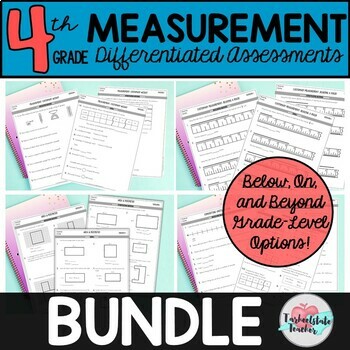4th Grade Measurement Assessments and Practice ALL STANDARDS BUNDLE
- Zip
What educators are saying
Products in this Bundle (17)
showing 1-5 of 17 products
Bonus
Description
These 4th Grade Measurement leveled assessments cover all common core standards for 4th grade measurement, including: converting customary weight, capacity, length, and time, metric system conversions, area and perimeter, line plots, angle measures concepts, and measurement word problems {4.MD.1, 4.MD.2, 4.MD.3, 4.MD.4, 4.MD.5, 4.MD.6, 4.MD.7}.
Three versions of each measurement assessment (labeled Version 1, Version 2, and Version 3) with three differentiated levels of mastery within each version (called "Building Blocks," "Goals," and "Stretching Beyond") ensure that you have what you need for pre-assessment, independent practice, post-assessment, review, and end of year test prep to meet a range of student abilities. With the “Building Blocks,” “Goals,” and “Stretching Beyond” leveled assessment options, you can collect invaluable data to drive your math instruction and provide all of your learners an opportunity to show true growth in their understanding of measurement concepts.
Leveled assessments align with a growth mindset approach to math learning, support you in making instructional decisions as you differentiate your math instruction, and make standards-based grading a breeze! With correlations between standards at three different levels of difficulty, teachers, students, parents, and other stakeholders have a clear continuum of learning for individual math standards and can leave "one-size fits all" math instruction behind!
The 4th Grade Measurement Leveled Assessments/Practice Set Includes 3+ Versions for each 4th Grade Measurement Standard, including:
Converting Units of Time
» Convert Units of Time and Elapsed Time
Elapsed Time Word Problems
» Convert Units of Time and Elapsed Time
Converting Customary Capacity
» Convert Gallons, Quarts, Pints, Cups, and Fluid Ounces
Converting Customary Weight
» Convert Ounces, Pounds, and Tons
Customary Capacity and Weight Word Problems
» Convert Gallons, Quarts, Pints, Cups, Fluid Ounces, Ounces, Pounds, and Tons
Reading a Ruler (Inches)
» Read a Ruler to the Nearest 1/2 or Whole Inch
» Read a Ruler to the Nearest 1/4 or 1/8 Inch
» Read a Ruler to the Nearest 1/16 Inch
Converting Customary Length
» Customary Length and Distance in Inches, Feet, Yards, and Miles
Customary Length and Distance Word Problems
» Convert Customary Length and Distance
Reading a Ruler (Centimeters/Millimeters)
» Read a Ruler Scaled in Centimeters To the Nearest Centimeter or 1/2 Centimeter
» Read a Ruler Scaled in Millimeters to the Nearest Centimeter or 1/2 Centimeter
» Read a Ruler to the Nearest Millimeter
Converting Metric Measurements
» Convert Metric Distance, Volume, and Mass
Metric Word Problems
» Convert Metric Units in Meters, Liters, and Grams
Area and Perimeter
» Apply Area and Perimeter Formulas For Rectangular Figures, Including Irregular Figures
» Solve Real-world Problems For Area
Line Plots
» Measuring Lines in Inches and Millimeters
» Read Clocks To Calculate Elapsed Time
» Read a Line Plot Scale That Includes Fractions
Measuring and Sketching Angles in Relation to a Circle
» Partition a Circle and Tell the Measure of Each Angle That is Created
» Create Acute and Obtuse Angles
» Use a Circle to Estimate and Sketch an Angle of a Given Measure
» Estimate and Sketch Reflex Angles in Relation to a Circle
Measuring and Sketching Angles with a Protractor
» Measure Different Types of Angles Using a Protractor to the Nearest 5 Degrees
» Sketch Different Types of Angles Using a Protractor to the Nearest 5 Degrees
Angle Measures as Additive
» Identify Supplementary, Complementary, and Full Circle Angles
» Solve For Unknown Angle Measures in Additive Angle Measure Problems
» Solve More Complex Additive Angle Measure Problems Where They Solve For Two Unknown Angles and Reflex Angles
Summative/End of Unit Measurement Tests
» Customary and Metric Measurement Conversions
» Area and Perimeter
» Geometric Measurement of Angles and Sketching
» Measure Angles in Relation to a Circle
Included in 4th Grade Measurement Leveled Assessments
✔ Hyperlinked (clickable) table of contents
✔ Standards based assessments for below, on, and above grade-level (144 pages of 16 assessment sets)
✔ 3 unique versions of each assessment to be used to measure mastery
✔ Summative assessments in below, on, and above grade-level for end of unit assessment on all of the standards in the domain (11 pages)
✔ All answer keys with detailed tips for understanding the standards and students’ mastery of specific skills when pertinent
✔ Ideas and notes on how to implement leveled math assessments (9 pages)
✔ Standards and Skills Trace that links the below grade-level and above grade-level standards to the on-grade level standards
✔ Classroom Data Trackers for the teacher
✔ Bar graphs for students to track growth for each domain
SAVE 20% ON DIFFERENTIATED ASSESSMENTS FOR ALL 4TH GRADE MATH STANDARDS WITH THE YEAR LONG BUNDLE!
***********************************************************************
Some of these 4th Grade Measurement Assessments also come in the following mini-bundles:
★ Converting Time and Elapsed Time Word Problems {Differentiated} BUNDLE
★ Angles Bundle 4.MD.5, 4.MD.6, 4.MD.7 {Differentiated Assessments}
★ Customary Conversions BUNDLE: Length, Capacity, Weight Differentiated Assessment
★ Metric Conversions BUNDLE: Meters, Liters, Grams Differentiated Assessments
Copyright © Tammy Roose, Tarheelstate Teacher





